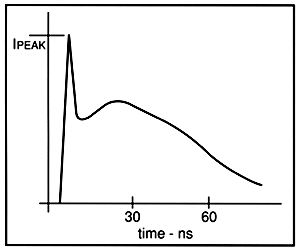 A
spark discharge flows through a channel that didn't exist before the current
began to flow....a boot strapping kind of event, so we'd expect the time
trace of the current to display the development stages of locally originating
systems.
A
spark discharge flows through a channel that didn't exist before the current
began to flow....a boot strapping kind of event, so we'd expect the time
trace of the current to display the development stages of locally originating
systems.
Descriptive physics:
Static electric discharge, ESD
PF Henshaw wrote[ sci.physics]:
>I’d be very interested in finding time traces of spark discharge
>currents that would provide a detailed display of their dynamics,
i.e.
>the detailed shape of the current development and decay process as
a
>whole, possibly including evidence of microscopic shock fronts,
>ionization flairs, turbulence or shudder, etc.
--
From: B A M Kruesemann [kruesemann@KVI.nl]
Sent: Monday, November 29, 1999 7:46 AM
To: ph@synapse9.com
Subject: Re: anyone have spark discharge current flow data?
Spark development: some molecules or atoms are ionized. The electrons are accelerated towards the anode, the ions are moving to the kathode. Because the electrons are much lighter that the ions, they are moving about 1000 times faster - and could ionize other molecules/atoms (secondary ionisation). Close to the anode, the number of secondary ionisated atoms rises exponentially, and the electrons form an Avalanche. In the case of a zylindric wire, the avalanche is drop-shaped. The ions from the avalanche region are now starting to move towards the kathode and are inducing a mirror charge on the anode. But that’s not yet a spark, because it is limited in time and volume, electron multiplication is limited to a very small area around the anode. A “spark” is usually an ionisation where photons cause additional ionisation. Photo ionisation is not as narrowly accumulated as the secondary electron ionisation, because their cross-section in gas is smaller. A rather big volume gets partly ionized and starts to “fire”, but never stops. That’s the reason why photo ionisation is mostly an undesired side effect in ionisation chambers, gas counters etc. It can be supressed by adding a “quenching gas”, i.e. a gas with a wide-band absorption spectrum. Isobutane or Ethane works well. Shock front effects from regular avalanche decharges are not known to me, as the ion movement is the only source of “turbulence”. But the ion speed is limited by friction - and somewhere there’s a constant “speed limit” for ions. As long as this maximum ion speed is below the sonic barrier (and that’s surely the case), no interesting new effects could be expected. Maybe this point is different with fully developed sparks, 1. because we can hear sparks 2. because the great number of ions could form a cylindric “tunnel” where the repulsing force between the +charges could cause the whole ion tunnel to expand very fast.
Current flow: If you are near the “breakdown voltage” (i.e. a gas counter
at the very edge to start sparking), you can observe a slight vibration
on your current-meter. More interesting, if you keep the counter at this
voltage, this current flutter stops sometimes, you can then rise the voltage
for another few volts. In wire-chamber physics, this is called “chamber
conditioning”. Nobody knows why this is working. Would beinteresting if
you find an answer to this unsolved mystery as a side effect of your original
research subject.